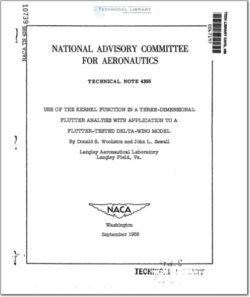NACA-TN-4395

- Version
- 178 Downloads
- 1.47 MB File Size
- 1 File Count
- March 24, 2016 Create Date
- March 24, 2016 Last Updated
National Advisory Committee for Aeronautics, Technical Notes - Use of the Kernel Function in a Three-Dimensional Flutter Analysis with Application to a Flutter-Tested Delta-Wing Model

The development and the numerical application are presented of a
Rayleigh—Ritz, or modal, type of flutter analysis which takes into
account three—dimensional structural and aerodynamic behavior. The
flutter mode is approximated by a series of natural—vibration modes,
and the aerodynamic forces corresponding to these modes are derived
from subsonic lifting-surface theory, according to the kernel-function
approach, for a finite wing oscillating in compressible flow.
The application is made to a delta semispan wing with a leading-
edge sweep angle of 15° which fluttered at a Mach number of 0.85. Results
of flutter calculations show that, for this case, when the first three or
four natural-vibration modes are used to approximate the flutter mode,
converged solutions for the flutter speed are obtained that are about
5 percent less than the experimental value. Theoretical flutter—speed
boundaries were located for a range of densities and Mach numbers
including those of the experimental-flutter condition. Further applica—
tion of the analysis to study the effects“ of variation in certain struc-
tural properties showed that the converged flutter speeds were more sen—
sitive to variations in the natural frequencies than to either variations
in mass or to the inclusion of generalized-mass coupling terms whose
existence is due to the use of experimental natural mode shapes.
Current aircraft-design trends, such as the use of thinner struc-
tures and external stores on aircraft capable of very high speeds, have
combined to diminish flutter safety margins and have, consequently,
increased the need for greater accuracy in flutter prediction. As a
result, both the structural and the aerodynamic aspects of the flutter
problem should be treated by use of more realistic methods than by the
beam-theory and strip-theory methods commonly employed in the past.
This report illustrates the development and application of a method
of flutter analysis which takes into account three—dimensional structural
and aerodynamic behavior. In treating the structural problem, the flutter
mode may be approximated by a series of either natural or assumed vibra—
tion modes which could have platelike distortions or shapes. In treating
the aerodynamic prdblem, lifting-surface theory is.used to obtain aero-
dynamic forces which take into account finite span and compressibility
as well as the modes of vibration of the structure.
| File | Action |
|---|---|
| naca-tn-4395 Use of the Kernel Function in a Three-Dimensional Flutter Analysis with Application to a Flutter-Tested Delta-Wing Model.pdf | Download |

Comment On This Post